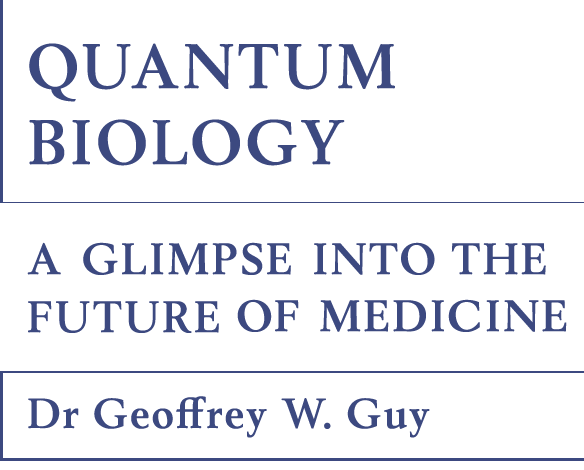
- About Geoffrey Guy
- List of chapters
- 1 Flatworms and xenobots
- 2 Beyond neurons: quantum effects in the brain
- 3 The ghost in the machine
- 4 Inflammation and equilibrium
- 5 The light fantastic
- 6 Lessons from the pandemic
- 7 Reassessing the causes of cancer
- 8 Energy, information and light
- 9 Before the origins of life
- 10 Unravelling the double helix
- 11 The computer in our cells
- 12 Space: the quantum frontier?
- 13 The quantum fractal
- 14 The path to mainstream
- Glossary
- Buy the book



12
Space: the quantum frontier?
This page provides online resources relating to Chapter 12 of Quantum Biology: A Glimpse into the Future of Medicine. Read a chapter extract, or scroll down to access figures and terminology, additional resources published by The Guy Foundation, and a list of further reading.
Name of the Chapter
Subheading
As I’ve said throughout this book, we believe that it is possible to explain nearly all the observations that have been reported in areas such as organ expansion, inflammatory processes, accelerated ageing and degenerative changes in cells, by mitochondrial dysfunction. We now understand the mitochondrion not as a biological organelle, but more as a mathematical and physical construct. There can be little doubt that we are altering the physics around it massively by taking it from the surface of the Earth to somewhere out in space. But published accurate figures are scarce.
… There is no point in just saying that theoretically these activities could inflict damage on people. We need a clear picture.
Buy the book here

Solar radiation distorts the Earth’s magnetic field.
A Faraday cage is designed to block out electromagnetic radiation. It is named after the nineteenth-century British physicist Michael Faraday, who discovered magnetic induction – the principle which lies at the heart of electric motors.
It is based on the principle that an electromagnetic field cannot pass through something which is conducting electricity. A microwave oven is a form of a Faraday cage, since it keeps microwaves trapped inside the machine as it heats the food. MRI scanners use Faraday cages to prevent radio signals from interfering with their operation.
The internationally accepted unit of measurement for the intensity of a magnetic field is the tesla (T). It is named in honour of the physicist, electrical engineer and inventor Nikola Tesla. A medical MRI scanner has a field strength of between 1.5T and 3T, while the magnetic field strength required to levitate a frog would be about 16T. The Earth’s natural magnetic field is about 25 to 65 millionths of a tesla (microteslas or μT).
2024 Space Health Report
The health hazards of space travel: novel insights from quantum biology
October 2024
Read the report here.
2023 Autumn Series Proceedings
Quantum Biology and Space Health
December 2023
2023 Space Symposium Proceedings
Advancing terrestrial health: lessons from space
February 2023
Videos

The Guy Foundation 2023 Autumn Series
Roundtable meeting
Dr Betony Adams, The Guy Foundation and University of Stellenbosch

The Guy Foundation 2023 Space Symposium
Are humans trapped on Earth?
Professor Geoffrey Guy, The Guy Foundation
Professor Alistair Nunn, The Guy Foundation and University of Westminster

The Guy Foundation 2023 Space Symposium
Mitochondria in space - the data in a nutshell
Dr Afshin Beheshti, NASA Ames Research Center

The Guy Foundation 2023 Space Symposium
Overview of magnetic fields in biology
Betony Adams, The Guy Foundation and University of Stellenbosch

The Guy Foundation 2023 Space Symposium
Reactive oxygen species (ROS) and stem cells
Professor Wendy Beane, Western Michigan University

The Guy Foundation 2023 Autumn Series
Mitochondria and space
Professor Douglas C Wallace, The Children's Hospital of Philadelphia Research Institute
Dr Afshin Beheshti, Blue Marble Space Institute of Science

The Guy Foundation 2023 Autumn Series
Microgravity and radiation effects
Dr David Furman, Buck Institute for Research on Aging
Professor Christopher D Porada, Wake Forest Institute for Regenerative Medicine

The Guy Foundation 2023 Autumn Series
Potential effects of magnetic fields
Professor Jonathan Woodward, The University of Tokyo
Professor Wendy Beane, Western Michigan University

The Guy Foundation 2023 Autumn Series
Quantum gravity and inertial stresses
Dr Nathan Babcock, Howard University
Professor Vlatko Vedral, University of Oxford

The Guy Foundation 2023 Space Symposium
Overview of oscillating gravitational fields in biology
Steve Thorne, The Copernican Project

The Guy Foundation 2023 Space Symposium
Microgravity and its effect on human physiology
Professor Alistair Nunn, The Guy Foundation and University of Westminster

The Guy Foundation 2022 Autumn Series
Mitochondria and fields: implications for space exploration
Dr Afshin Beheshti, NASA Ames Research Center

The Guy Foundation 2022 Autumn Series
Mitochondria and magnetic fields, spin and reactive oxygen species
Professor Clarice Aiello, UCLA
Professor Wendy Beane, Western Michigan University

The Guy Foundation 2022 Autumn Series
Mitochondrial dysfunction: relevance for Chronic Fatigue Syndrome and long COVID
Professor Karl Morten, University of Oxford
Also visit The Guy Foundation YouTube Channel Mitochondria Playlist
See the Playlist.
Walter F. Boron and Emile L. Boulpaep, Medical Physiology (Amsterdam: Elsevier, 2016)
Willian A. da Silveira, Hossein Fazelinia, Sara Brin Rosenthal et al., ‘Comprehensive multi-omics analysis reveals mitochondrial stress as a central biological hub for spaceflight impact’, Cell 183:5 (2020), doi.org/10.1016/j.cell.2020.11.002
Noburu Ikeya and Jonathan R. Woodward, ‘Cellular autofluorescence is magnetic field sensitive’, PNAS 118:3 (2021), doi.org/10.1073/pnas.2018043118
Xiaohua Lei, Yujing Cao, Baohua Ma et al., ‘Development of mouse preimplantation embryos in space’, National Science Review 7:9 (2020), doi.org/10.1093/nsr/nwaa062
National Academies of Sciences, Engineering, and Medicine, Thriving in Space: Ensuring the Future of Biological and Physical Sciences Research: A Decadal Survey for 2023–2032 (Washington, DC: The National Academies Press, 2023), doi.org/10.17226/26750
Steve Thorne, ‘Modeling the role of gravitation in metabolic processes’, Communicative & Integrative Biology 14:1 (2021), doi.org/10.1080/19420889.2021.1914913
Alanna V. van Huizen, Jacob M. Morton, Luke J. Kinsey et al, ‘Weak magnetic fields alter stem cell-mediated growth’, Science Advances 5:1 (2019), doi.org/10.1126/sciadv.aau7201
Bingfang Zhang, Lei Wang, Aisheng Zhan et al., ‘Long-term exposure to a hypomagnetic field attenuates adult hippocampal neurogenesis and cognition’, Nature Communications 12 (2021), doi.org/10.1038/s41467-021-21468-x
